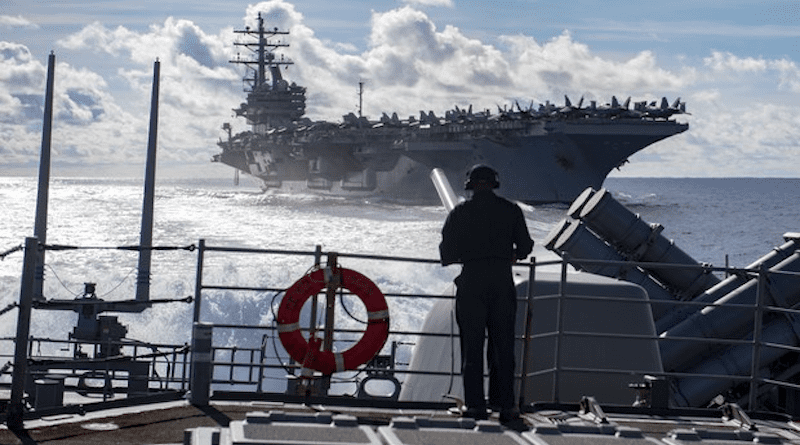China Accuses US Navy Of ‘Violating Its Sovereignty’ In South China Sea
By RFA
The U.S. Navy on Tuesday rejected China’s claim that it had “tracked and dispelled” a U.S. warship from waters near Spratly Islands in the South China Sea that China claims almost in its entirety.
Senior Col. Tian Junli, spokesman of the People’s Liberation Army Southern Theater Command, said in a press statement that earlier in the day the U.S. Navy’s guided missile cruiser USS Chancellorsville “trespassed into the waters adjacent to China’s Nansha (Spratly) islands and reefs.”
The Southern Theater Command also released a map purportedly showing the location of the U.S. warship near Fiery Cross, an artificial island that China has reclaimed and militarized.
“The Southern Theater Command organized naval and air forces to track and dispel the U.S. ship,” Tian said.
“The actions of the U.S. military have seriously violated China’s sovereignty and security, which is another ironclad evidence of its pursuit of navigation hegemony and militarization of the South China Sea,” the Chinese spokesman said, adding that “China has indisputable sovereignty over the islands in the South China Sea and their adjacent waters.”
In a reply to RFA, a U.S. Navy spokesperson dismissed the PLA accusation, calling it “false.”
“USS Chancellorsville (CG 62) conducted this FONOP (Freedom of Navigation Operation) in accordance with international law and then continued on to conduct normal operations in waters where high seas freedoms apply,” the spokesperson’s statement said.
“The United States is defending every nation’s right to fly, sail, and operate wherever international law allows, as USS Chancellorsville did here.”
“Nothing the PRC says otherwise will deter us,” it said, referring to China by its official name – the People’s Republic of China.
‘Unlawful and sweeping maritime claims’
USS Chancellorsville is a Ticonderoga-class guided-missile cruiser currently deployed to Carrier Strike Group 5, part of the U.S. Navy’s 7th Fleet. It is homeported in Yokosuka, Japan.
On Aug. 28, 2022, Chancellorsville and its sister ship Antietam conducted a routine transit through the Taiwan Strait. It was the first such passage since a visit to Taiwan the same month by U.S. House Speaker Nancy Pelosi that angered Beijing.
The U.S. Navy’s statement said that earlier on Tuesday the USS Chancellorsville “asserted navigational rights and freedoms in the South China Sea near the Spratly Islands, consistent with international law.”
“At the conclusion of the operation, USS Chancellorsville exited the excessive claim area and continued operations in the South China Sea,” the statement said.
The PLA Southern Theater Command’s claim was “the latest in a long string of PRC actions to misrepresent lawful U.S. maritime operations and assert its excessive and illegitimate maritime claims at the expense of its Southeast Asian neighbors in the South China Sea.”
The U.S. Navy’s statement pointed out that the United States “challenges excessive maritime claims around the world regardless of the identity of the claimant.”
“Unlawful and sweeping maritime claims in the South China Sea pose a serious threat to the freedom of the seas,” enjoyed by all nations with a coastline.
‘Innocent passage’
China, Vietnam, Taiwan, Malaysia, Brunei, and the Philippines hold overlapping claims over parts of the South China Sea, but the Chinese claims are the most excessive.
According to the U.S. Navy, only China, Vietnam and Taiwan “purport to require either permission or advance notification before a foreign military vessel engages in “innocent passage” through the territorial sea.”
“The United States challenged these requirements,” the statement from the U.S. Navy said, adding that “innocent passage is not subject to such restrictions” under customary international law as reflected in the Law of the Sea Convention.
Before the USS Chancellorsville, another U.S. warship – the guided-missile destroyer USS Benfold – also sailed near the Spratlys in July provoking an angry response from the PLA.
The USS Benfold also conducted what the U.S. calls “innocent passage” near Paracel islands, in the South China Sea, in July and February, 2022.

